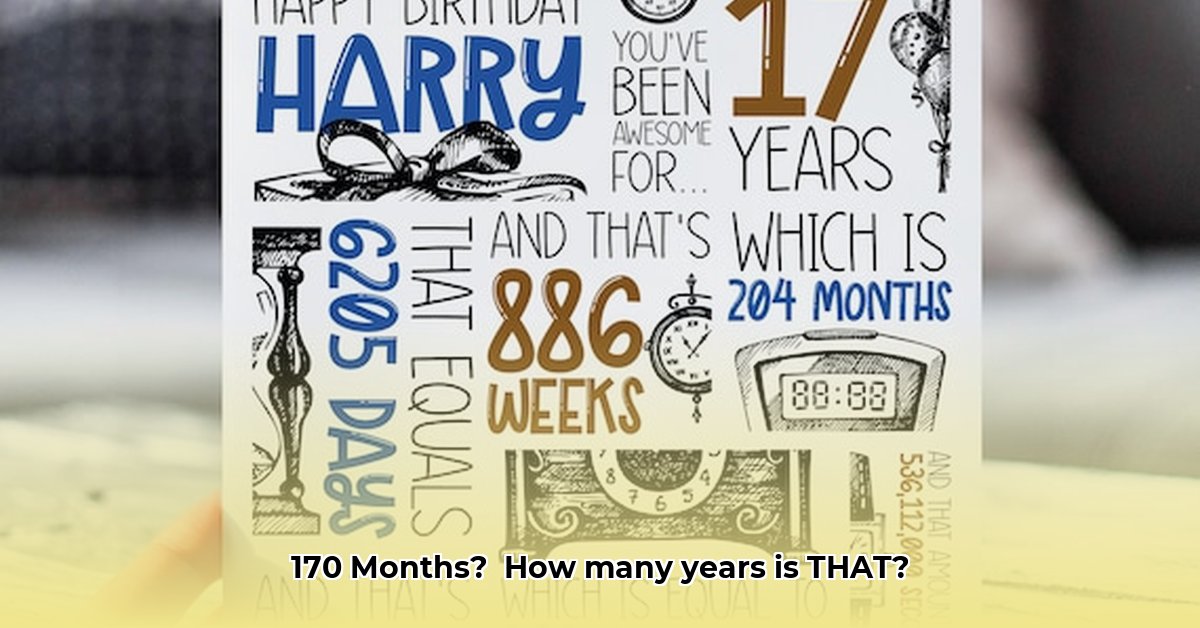
Converting 170 months into years isn't as straightforward as simply dividing by 12. This guide provides several methods, from a quick estimate to highly accurate calculations, considering the varying lengths of months and the impact of leap years. For more examples on time conversions, check out this helpful resource: Calculating Months to Years.
Method 1: The Quick, Approximate Calculation
The simplest approach is to divide 170 months by 12 months per year: 170 / 12 ≈ 14.17 years. This provides a quick estimate, but it lacks precision because it doesn't account for the varying lengths of months within a year. It's useful for rough estimations but not suitable for applications requiring accuracy.
Method 2: Refining the Estimate with Average Month Length
For a more accurate result, we utilize the average length of a month. A common approximation for the average length of a month is 30.437 days.
- Calculate total days: 170 months * 30.437 days/month ≈ 5174 days
- Convert to years: 5174 days / 365.25 days/year ≈ 14.17 years (This accounts for leap years using an average year length of 365.25 days).
While more accurate than simple division, this method still employs an average and thus might not reflect the exact number of years. This method is suitable for scenarios where moderate accuracy is sufficient.
Method 3: Precision through Month-by-Month Calculation
The most accurate method involves a detailed month-by-month calculation. This requires knowing the starting date and involves calculating the exact number of days in each month, considering leap years. This approach is best suited for situations requiring maximum accuracy.
For example, if starting on January 1st, 2023, the calculation would involve adding 170 months to this date and then determining the difference in years. A spreadsheet program or programming code is ideal for this complex but precise method.
Method 4: Leveraging Spreadsheet Software or Programming
Spreadsheet software (like Excel or Google Sheets) or programming languages (like Python) offer the most accurate and efficient method for this type of conversion, especially when dealing with numerous conversions. These tools allow you to input a start date and add 170 months, automatically calculating the resulting date and the precise number of years and months. This approach eliminates manual calculations and reduces the risk of errors.
Comparing the Methods: Accuracy vs. Effort
The optimal method depends on the required level of accuracy.
| Method | Accuracy | Effort Level | Use Cases |
|---|---|---|---|
| Simple Division | Low | Very Low | Quick, rough estimates |
| Average Month Length | Medium | Low | Situations requiring moderate accuracy |
| Month-by-Month Calculation | High | High | High-accuracy applications, financial calculations |
| Spreadsheet/Programming | Highest | Medium | Large datasets, efficient repetitive calculations |
Real-World Applications of Accurate Time Conversion
Precise conversion of months to years is vital across numerous fields:
- Finance: Calculating loan repayment schedules, compound interest, and investment returns.
- Project Management: Estimating project durations and milestones.
- Data Analysis: Working with time-series data that needs to be aggregated into yearly summaries.
- Legal: Determining contract and lease durations.
By selecting the most suitable method based on your needs, you can ensure accurate and reliable time conversions in your calculations. Remember to consider the balance between speed and precision when deciding which method is best for your particular application.